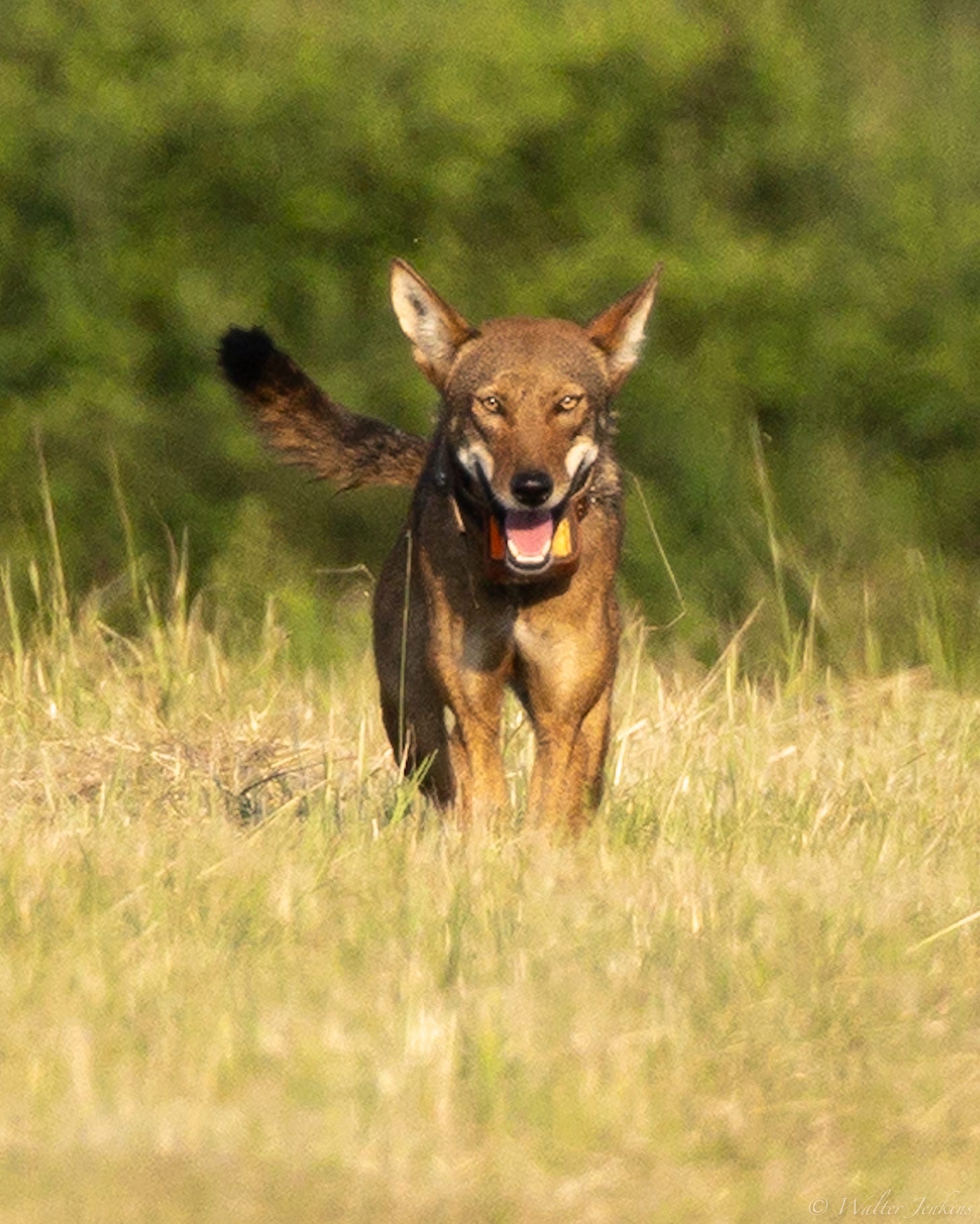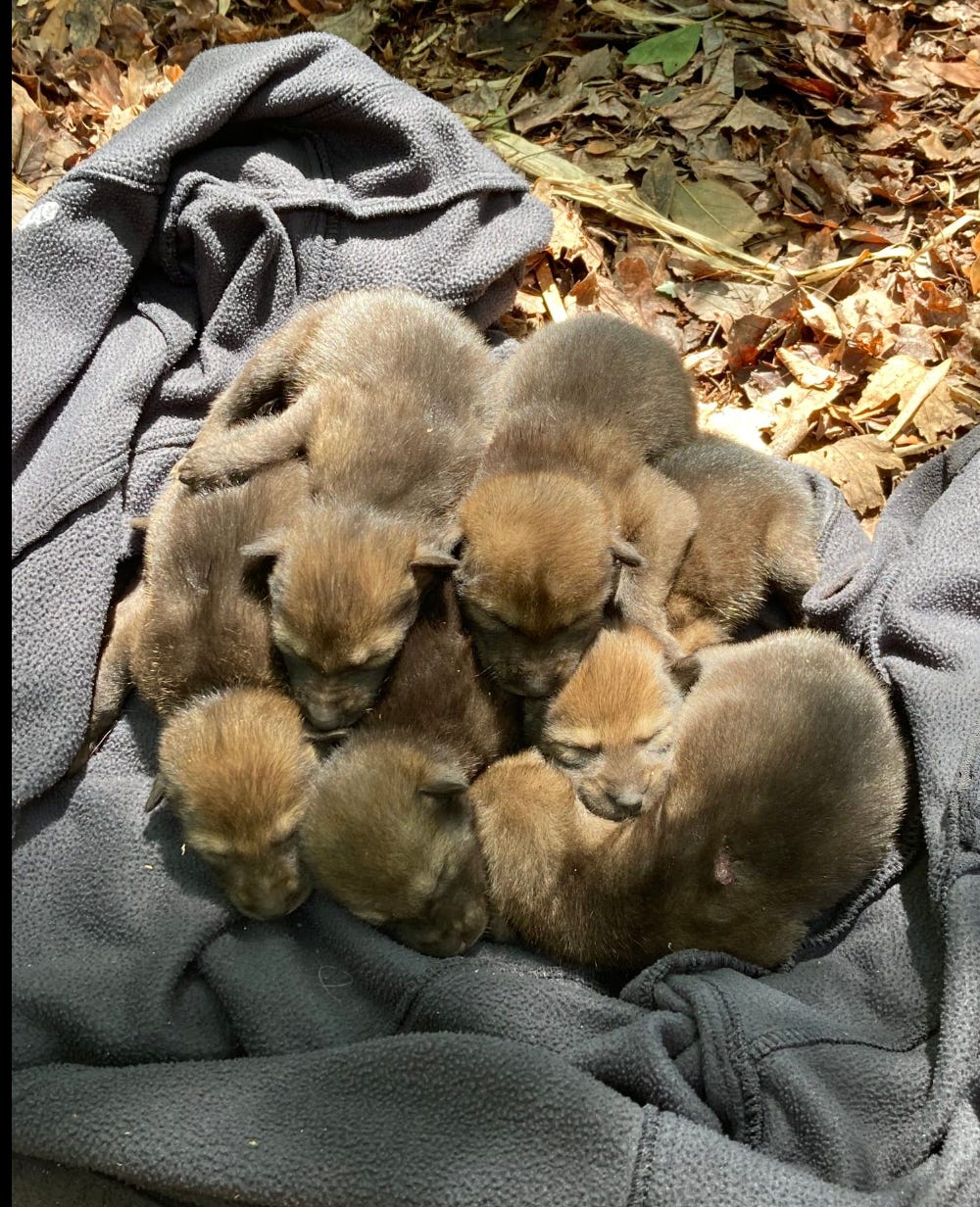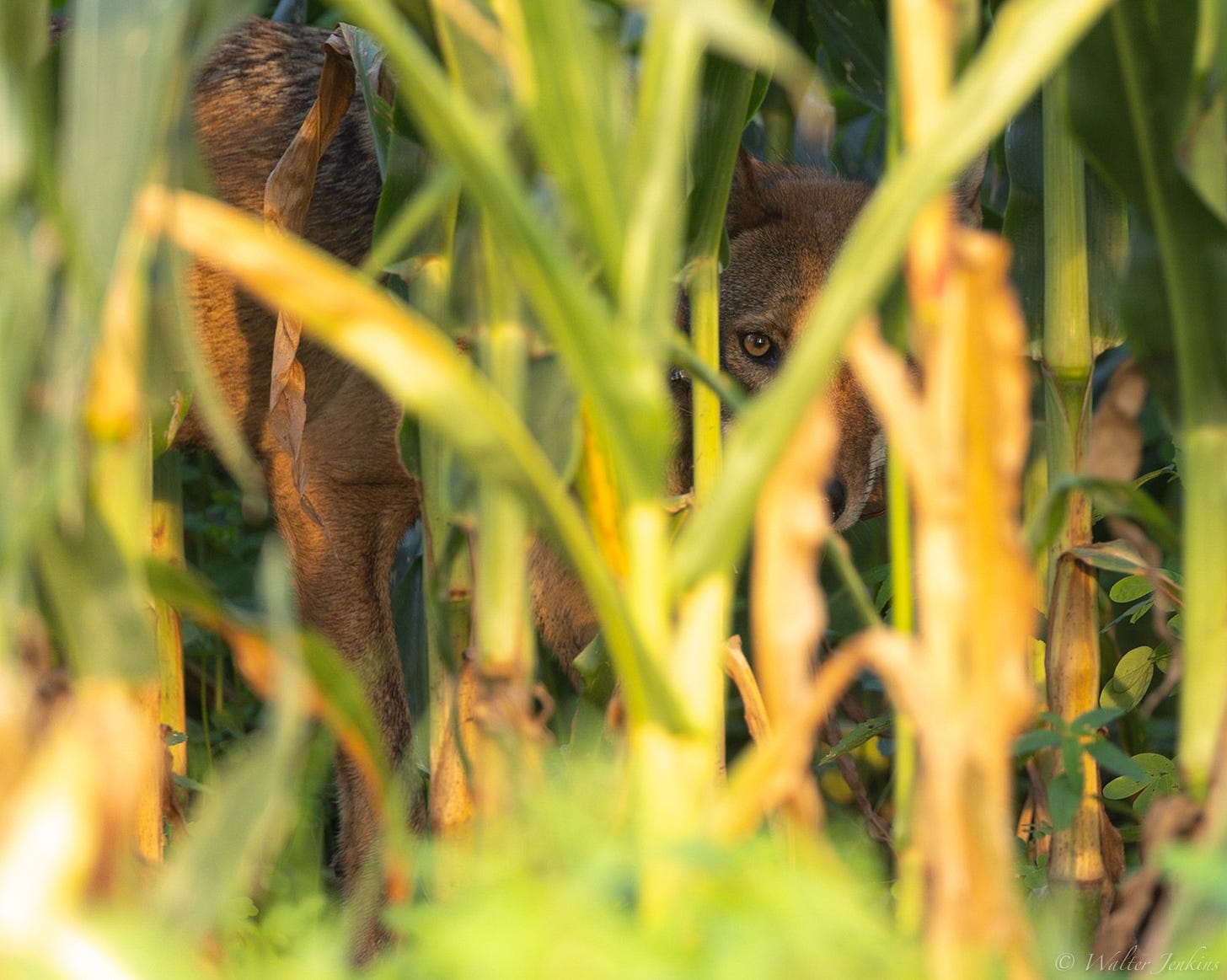Raised by (foster) wolves
happy happy hope hope
I’m working on a response to the recent, explosive dire wolf de-extinction announcement from Colossal Biosciences, which is sexy and scary and exciting and of course complex. Dire is just so perfect a word— extremely urgent, serious; potentially (though not necessarily) disastrous. It’s been all over the news since — it’s an abomination, a breakthrough, shameful, miraculous… More crucial (to me) and more immediately related to my ongoing book project: in the same press release Colossal shared that it also cloned four red wolves (actually admixtures with “ghost” red wolf DNA — again, complicated! As is so much that happens in the orbit of this ongoing recovery effort). I’ve been contemplating, thinking about “hot takes,” and hyper-objects—concepts, like extinction, that are too big for our brains to fully grasp. I have been researching and learning about de-extinction for the last few years, along with other re-wilding efforts and controversies and differing opinions about how to save endangered species, when, as Steward Brand said in the 1968 Whole Earth Catalog, “We are as gods” on this planet… Lots of fascinating stuff continues to happen. Anyway I will post about that very soon.
But in the meantime… how about something pretty simply straight-up happy and hopeful?
2361F, named Utaʔkrękę·haʔnęʔ Kakúʔę, which means ‘Mother of a Nation’ by members of the Tuscarora Nation of NC, nicknamed “Spring” —breeding female of the Pungo Pack in Pocosin Lakes Refuge — her amazing story below. Photo Walt Jenkins
Do y’all know about pup fostering? I know some of you reading this SubStack definitely do—but some might not have heard about this truly amazing initiative, developed first in the red wolf recovery program, which helps to increase the genetic diversity of critically endangered canids and improves their chances of surviving in the wild. It also illustrates just how well and skillfully red wolves take care of their families (and how naturally skittish they are around humans). Red wolves only mate and reproduce once a year, and right around now, in late April/early May, is when litters of pups start arriving in zoos and natures center and also—one hopes!—in the refuges where wild red wolves live. In the spirit of this period of growth, and renewal, and rebirth, and resurrection, below please find a brief recounting of one of many successful foster stories.
On a warm, clear morning in May of 2021, a mother wolf lies curled beside a litter of six newborn pups when her ears prick at the sound of something approaching. Her den is well-concealed; still, she tenses as the noises reach her over the steady drone of insects: snapping twigs, rustling leaves. She waits until the last moment, then bolts, leaving the pups in a helpless huddle, eyes still closed to the world, as the intruders close in…
Actual photo of the actual wild-born pups in their actual den! US Fish & Wildlife, 2021
Earlier that same morning, in another red wolf den—this one a metal box at the Akron Zoo, five hundred miles west—keepers carefully remove four days-old pups from a litter of eight. Among these is 2361F, a female—the two thousand, three hundred and sixty-first descendant of the fourteen "founding wolves" who kick-started this species' comeback from extinction in the 70's. The zoo pups are carefully wrapped in blankets, then transported via van to plane, where a volunteer pilot takes them to an airfield on the Outer Banks, where a team of federal biologists are waiting. The biologists then drive the zoo pups to the refuge, and carry them through buggy fields to the same den in the stand of sweet gum and swamp pines. Here, as the mother wolf crouches in undergrowth not far away, they are gently rubbed against the resident pups, to gain their scent and help facilitate acceptance. Once all the pups are nestled in the den once more, the humans depart.
The pups from the wild den and their new zoo-born siblings, warming in the sun before being placed back in the den. Photo courtesy US Fish & Wildlife. May 2021
The exhaustive, time-sensitive process known as pup fostering is one of several innovations developed by the Red Wolf Recovery Program over the past thirty years that have greatly benefited not only this species but other reintroduction programs worldwide. Placing zoo-born pups in dens to be raised by wild mothers not only helps increase genetic diversity amongst the population, it also increases the chances for survival outside captivity; the best way for wolves to learn how to live is from their parents, who pass on generations of wisdom about things like how and where to hunt and den. Pup-fostering's near-100-percent success rate is due in large part to red wolves being “a very compassionate and dedicated family species,” says Chris Lasher, Program Leader for the Association of Zoos and Aquariums’ Red Wolf SAFE program.
Not long after 2361F and her siblings are placed in the wild den, they are moved again, this time by their mother, who carries all the pups, one by one, to a new site. This is typical behavior after a den disturbance. Scientists monitoring the mother wolf’s movements via tracking collar observe that she continues to stay in the area, a good sign that she is caring for the pups.
One year later, all eight are caught, fitted with orange tracking collars, and re-released. Though several other wolves had succumbed to poaching and vehicle strikes during that period, 2361F and her siblings were some of the few captive-born red wolves to survive, thanks to the skills they’d gleaned about living wild from their adoptive parents.
Here she is after being trapped and fitted with a trapping collar. Photo from US Fish & Wildlife
2361F, a yearling now, shown after being caught and fitted with a tracking collar before re-release. Photo USFWS
My favorite part: one year later, in June of 2023, 2361F is seen on a wildlife camera leaving an opened acclimation pen with her new mate and their 6-week-old-pups—a mother herself, now, venturing back into the wild to teach the next generation of red wolves the art of survival.
A still shot of 2361F and her mate from remote camera footage, venturing back into the wild of Pungo with her pups.
Video here (hope the link works—it’s SO worth watching!
From the Recovery Program, about how this process works behind the scenes: using radio telemetry, biologists monitor wild red wolf females starting in mid-April and document when and where they begin to stay in a single location, indicating they have denned and given birth.
Meanwhile, coordination with the red wolf Species Survival Plan (*now called SAFE, Saving Animals From Extinction*) occurs to try and match up the timing of the birth of a wild litter with a captive born litter… Time is a critical factor when integrating pups into a litter. Biologists must ensure that the captive born pups are close in age to the wild born pups and ideally no more than two weeks old as the mother’s maternal instinct is very strong with pups of this age, which decreases the likelihood of pup rejection. Also, the pups have limited mobility at that age, and they are more likely to stay in the den and not wander off before the mother returns. Things must happen relatively quickly to make sure the captive pups are not without a mother for too long, and to make sure the wild mother is not away from her den any longer than necessary. While the mother is away from the den temporarily hunting, biologists place the captive pups in the den with their new wild siblings. They are rubbed together to transfer scent from the wild pups to the captive pups. They receive a Passive Integrated Transponder (PIT) tag for future identification (similar to microchip tags used to identify lost pets). Once this is done and the pups settle, biologists leave the den quickly to allow the wild mother to return.
More info about 2361F from the Save Red Wolves site from the Center for Biological Diversity (click the link to learn more about what you can do to help):
Her Tuscarora name means ‘Mother of a Nation’ in the language of the Tuscarora Nation of North Carolina. Spring gave birth to two females in 2023. She is matriarch of the only wolf pack in Pocosin Lakes National Wildlife Refuge.
2361F peeking out from a cornfield, taken with Zoom lens, photo by Walt Jenkins.
I’m going to end here, for now.
Hoping more red wolf pups are on the horizon soon… Hoping you can have a beautiful and restorative day.









Note: I caught a few errors myself, immediately upon posting--as tends to happen often, as soon as I've click "send"... Anyway: I updated/corrected info about the den site, 2361F's Tuscarora name....